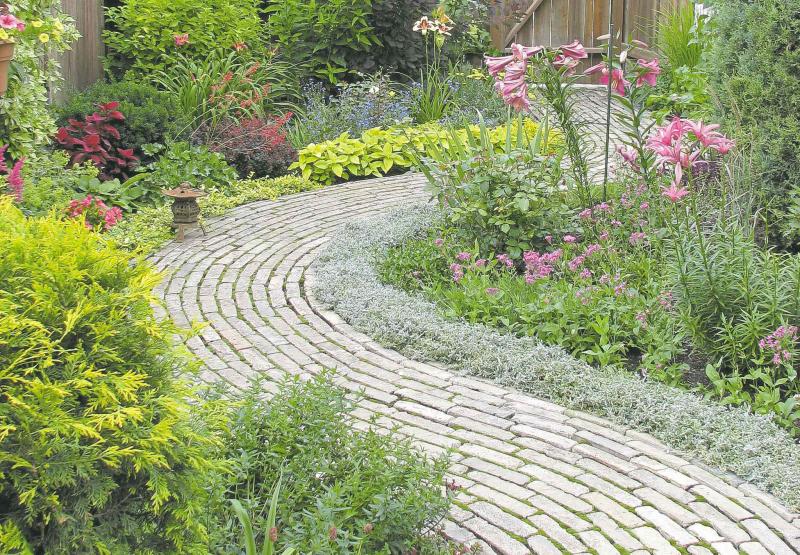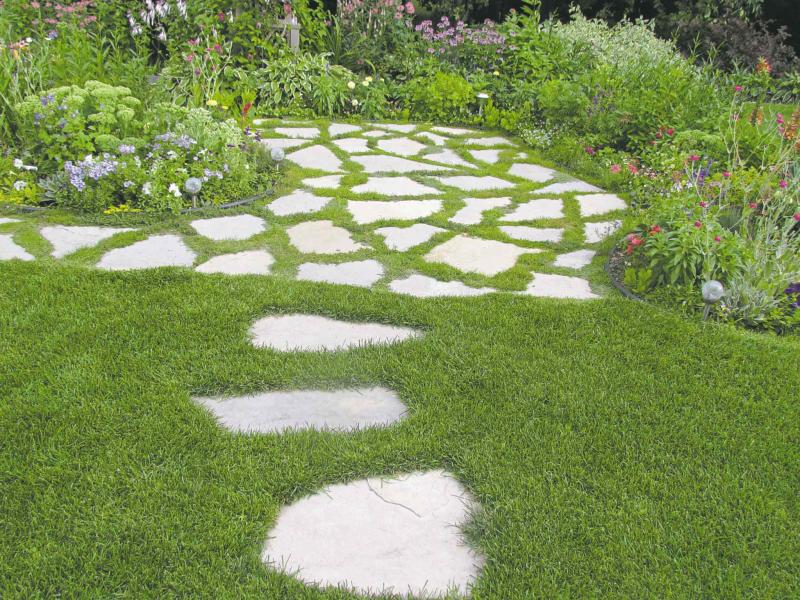
Exposed to time and the elements as well as frequent foot traffic, a worn brick or stone pathway as it winds its way to a quaint manor or cottage garden, often serves as the enchanting prelude to the visitor experience.
Any design of garden pathway, curved or linear, that utilizes reclaimed brick invariably produces sighs and admiring glances. The patina of reclaimed brick or flagstone, complete with ribbons of moss or creeping thyme, is hugely appealing. Reclaimed bricks can even be laid on their sides for a singular effect.
Loaded with character, it's a look that can be found, carefully recreated, in even the most modern neighbourhoods.
The sleek, contemporary lines of Alan and Donna Cheung's Winnipeg home have been complemented by the angular shapes of hand cut flagstone in their natural flagstone walkway and patio. With a vision in mind to create a pathway and patio in an area that was primarily lawn, they visited Mariash Quarry, a self-described do-it-yourself stone quarry in Stonewall, north of Winnipeg, and selected their stone.
Alan purchased a masonry saw and a masonry grinding disc and hand bevelled the edges of each piece of flagstone to remove any sharpness to ensure a smoother and safer walking experience.
After removing all traces of sod in the designated area for the pathway and patio, Alan excavated the soil to a depth of about seven to 10 centimetres. He compacted the base by pounding it evenly, spraying it first with water and breaking up any high points with a shovel, then removed any loose soil. Next, he added a layer of sand to a depth of about 4 cm, firming it into place.
Laying the flagstone proved a bit trickier as the thickness of each varied by a centimetre or so. He used a masonry saw to reshape some of the flagstone in order to achieve the desired effect. Alan even added a few notches for as natural a look as possible.
It might have been easier to use a precast product from Barkman such as Rosetta Grand Flagstone which has a texture and scale designed to resemble natural stone. The thickness of each slab is consistent for easy installation. Donna and Allen, however, relished the notion of a hands-on stonescaping project. Setting the irregular pieces of flagstone into place, though, was only one aspect of the overall project.
Alan left a space of approximately 1/2 cm between each stone. He used a wet dry vacuum to suction out most of the sand and then he and Donna laboriously removed the rest by hand, adding it to a wheelbarrow filled with loamy soil. They added water to the mix until it had the consistency of a slurry then used it to fill all of the spaces between the stones. Next they proceeded to plant an assortment of ground hugging, creeping plants such as woolly thyme, lemon thyme, elfin thyme, and Scotch moss.
The summer's warmth, sunshine and timely rainfall has resulted in lush, green growth. Elfin thyme, Donna's favourite, boasts particularly dense growth. For now they are experimenting with various ground covers but may decide to go solely with elfin thyme which spills onto the flagstone, softening its edges.
The finished project invites visitors to stroll down the flagstone pathway which leads to the flagstone patio. Herbaceous perennials encircle the outside edges of the patio allowing for ease of maintenance as well as a picturesque view from inside the house and deck that is directly opposite.
What is it about moss planted between stones or pavers that is so attractive to us? Both Alan and Donna love the tiny pale lilac flowers of Scotch moss but find it too aggressive. It self-seeds vigorously, sometimes popping up in other parts of the landscape. It is also easy to propagate. If a piece comes loose during sweeping or walking on the stones, Donna tucks it back into place where it roots quickly.
If you want the same mossy look using brick pavers, keep in mind that the heat radiating from a hardscaping material can cause ground cover to dry out quickly. During high heat in mid-summer, maintain enough moisture to prevent browning. Alan lightly sprays his walkway and patio and eventually the water that pools on the surface of the stone makes its way into the grooves.
Walkways may be wide or narrow or include a variety of stones. Sometimes the design is reminiscent of a pattern that the homeowner admires or naturally gravitates to for one reason or another. Symmetry, for example, is often a component in the design of an herb garden. Shelley Walker is a member of the Herb Society of Manitoba and a volunteer at the herb garden at Assiniboine Park. The wide pathway that leads from the deck in her backyard to her garden is akin to a courtyard and suggestive of the geometrical design often found in formal herb gardens.
The do-it-yourself project which she and her husband designed consists of two different sizes of pavers, square and rectangular, aligned in a series of linear and horizontal rows that frame square blocks of exposed aggregate patio slabs, each one measuring 40 by 40 centimetres. Moss grows between the pavers for an appealing, old world effect.
When Anne Peters decided to create a garden pathway for her Steinbach residence, she decided to create a distinctive checkerboard with 45 cm square concrete patio slabs. After removing the top layer of sod, she excavated a layer of soil and added a base of crushed stone. Using pegs which she tapped into the ground as well as string, Peters created a grid to ensure the precise placement of the patio slabs. Equally precise in their placement and dimensions are the alternate squares that consist of thick, healthy grass. The pathway widens in the area of a privacy screen in her backyard then narrows as it meanders to the front door.
Sometimes even a crumbling walkway has a certain charm. That charm ends though as soon as you stumble on an uneven surface, possibly twisting your ankle, or watch in horror as your visitor pitches forward into a nearby flower bed.
Why do our best laid plans shift? Often our extreme climate, with its dependable freeze thaw cycles, plays a role. Excavating deeper, sometimes to as much as 45 cm to 60 cm, and laying down heavy duty landscape fabric before filling with a compacted base of down crushed limestone can help to ensure the integrity of the base for hardscaping, says Paul van Gils, owner of Vangils Landscape Design and Construction.
Should a hardscaping pathway be installed directly adjacent to the foundation of a house? van Gils doesn't recommend it. "The area next to the foundation of a home tends to be more at risk for settling," said van Gils.
In the dry summer of 2012, Winnipeggers were advised to water their foundations. Many homeowners whose hardscaping was up against their foundations saw stone and brickwork lift unevenly. He recommends a strip of decorative gravel alongside the walkway to separate it from the foundation of the house or better yet, a planting bed which holds moisture.
He also touts the advantages of heated walkways to eliminate the possibility of ice buildup. An intriguing idea finding growing interest in cold climate regions in North America, a heated glycol liquid system is installed beneath stone pavers when a walkway is constructed. This works particularly well with interlocking pavers, says van Gils, because they offer greater traction than smooth cement. Equipped with a timer and an on off switch, usually located in the garage, the homeowner never has to worry about ice or snow buildup again.
Tempting.
Colleenizacharias@gmail.com




